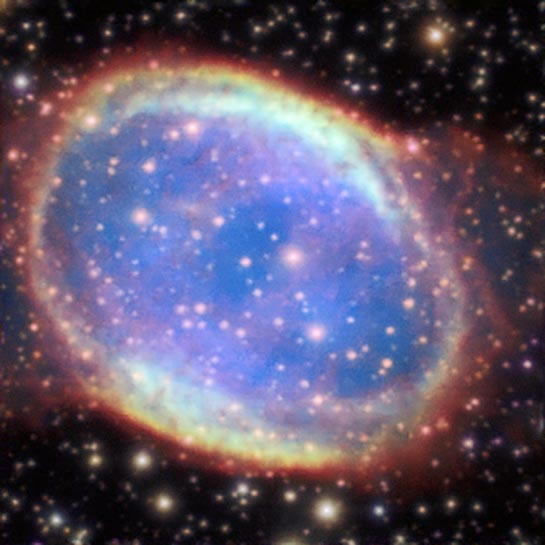
Observed with the AOF
Planetary nebula
RA 18h 12m 02.6s Dec -33° 52' 04"
Sagittarius
3100 light-years
12.5
54 "x 41"
ESO/P. Weilbacher (AIP)
August 2, 2017
ABOUT THIS IMAGE:
NGC 6563 is a planetary nebula in the constellation of Sagittarius. It was was discovered by the astronomer James Dunlop in 1826.This image is one of the first taken by ESO's Very Large Telescope using adaptive optics which minimizes atmospheric turbulence.
The Adaptive Optics Facility (AOF) is a long-term project on ESO’s Very Large Telescope (VLT) to provide an adaptive optics system for the instruments on Unit Telescope 4 (UT4), the first of which is MUSE (the Multi Unit Spectroscopic Explorer). Adaptive optics works to compensate for the blurring effect of the Earth’s atmosphere, enabling MUSE to obtain much sharper images and resulting in twice the contrast previously achievable. MUSE can now study even fainter objects in the Universe.
Following a battery of tests on the new system, the team of astronomers and engineers were rewarded with a series of spectacular images. Astronomers were able to observe the planetary nebulae IC 4406, located in the constellation Lupus (The Wolf), and NGC 6369, located in the constellation Ophiuchus (The Serpent Bearer). The MUSE observations using the AOF showed dramatic improvements in the sharpness of the images, revealing never before seen shell structures in IC 4406
The AOF, which made these observations possible, is composed of many parts working together. They include the Four Laser Guide Star Facility (4LGSF) and the very thin deformable secondary mirror of UT4. The 4LGSF shines four 22-watt laser beams into the sky to make sodium atoms in the upper atmosphere glow, producing spots of light on the sky that mimic stars. Sensors in the adaptive optics module GALACSI (Ground Atmospheric Layer Adaptive Corrector for Spectroscopic Imaging) use these artificial guide stars to determine the atmospheric conditions.
One thousand times per second, the AOF system calculates the correction that must be applied to change the shape of the telescope’s deformable secondary mirror to compensate for atmospheric disturbances. In particular, GALACSI corrects for the turbulence in the layer of atmosphere up to one kilometre above the telescope. Depending on the conditions, atmospheric turbulence can vary with altitude, but studies have shown that the majority of atmospheric disturbance occurs in this “ground layer” of the atmosphere.